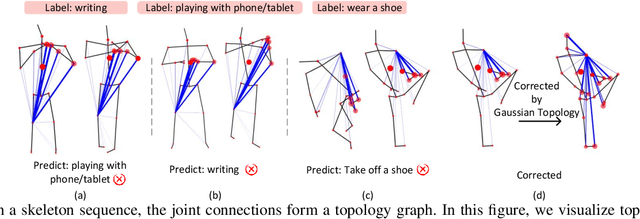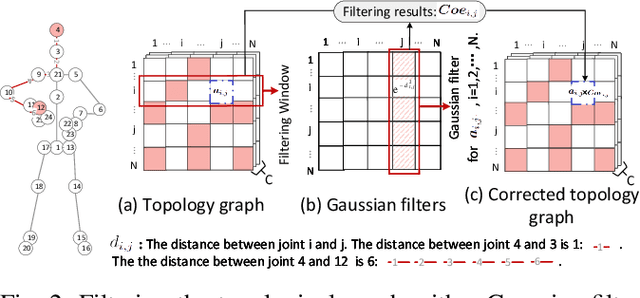Haiqing Ren
G3CN: Gaussian Topology Refinement Gated Graph Convolutional Network for Skeleton-Based Action Recognition
Sep 09, 2025



Abstract:Graph Convolutional Networks (GCNs) have proven to be highly effective for skeleton-based action recognition, primarily due to their ability to leverage graph topology for feature aggregation, a key factor in extracting meaningful representations. However, despite their success, GCNs often struggle to effectively distinguish between ambiguous actions, revealing limitations in the representation of learned topological and spatial features. To address this challenge, we propose a novel approach, Gaussian Topology Refinement Gated Graph Convolution (G$^{3}$CN), to address the challenge of distinguishing ambiguous actions in skeleton-based action recognition. G$^{3}$CN incorporates a Gaussian filter to refine the skeleton topology graph, improving the representation of ambiguous actions. Additionally, Gated Recurrent Units (GRUs) are integrated into the GCN framework to enhance information propagation between skeleton points. Our method shows strong generalization across various GCN backbones. Extensive experiments on NTU RGB+D, NTU RGB+D 120, and NW-UCLA benchmarks demonstrate that G$^{3}$CN effectively improves action recognition, particularly for ambiguous samples.
A New Hybrid-parameter Recurrent Neural Networks for Online Handwritten Chinese Character Recognition
Jul 30, 2018



Abstract:The recurrent neural network (RNN) is appropriate for dealing with temporal sequences. In this paper, we present a deep RNN with new features and apply it for online handwritten Chinese character recognition. Compared with the existing RNN models, three innovations are involved in the proposed system. First, a new hidden layer function for RNN is proposed for learning temporal information better. we call it Memory Pool Unit (MPU). The proposed MPU has a simple architecture. Second, a new RNN architecture with hybrid parameter is presented, in order to increasing the expression capacity of RNN. The proposed hybrid-parameter RNN has parameter changes when calculating the iteration at temporal dimension. Third, we make a adaptation that all the outputs of each layer are stacked as the output of network. Stacked hidden layer states combine all the hidden layer states for increasing the expression capacity. Experiments are carried out on the IAHCC-UCAS2016 dataset and the CASIA-OLHWDB1.1 dataset. The experimental results show that the hybrid-parameter RNN obtain a better recognition performance with higher efficiency (fewer parameters and faster speed). And the proposed Memory Pool Unit is proved to be a simple hidden layer function and obtains a competitive recognition results.
 Add to Chrome
Add to Chrome Add to Firefox
Add to Firefox Add to Edge
Add to Edge